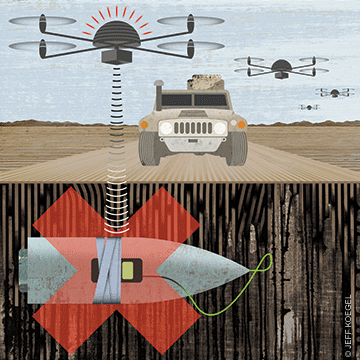
“It’s amazing how much time goes into making a 10-minute presentation,”says Engineering sophomore Richard Zhang. Almost five months, in his case.
The preparation paid off for Zhang, classmate Kelsey Duncombe-Smith, and Wharton doctoral student Andy Wu—the trio behind “team IDENTIFIED,” which won $5,000—plus a free license to cutting-edge intellectual property—as part of the first annual Penn Y-Prize Competition in February.
It seems like scarcely a week goes by without a university somewhere staging a cash-prize competition. At Penn alone, there is the Wharton Business Plan Competition, the Weiss Tech House’s PennVention Competition, and the Milken-Penn GSE Education Business Plan Competition.
You might think that a saturation point had been reached.
But the Y-Prize, sponsored by six Penn schools and centers plus the National Science Foundation and a few private companies, has an interesting twist. Participants were challenged to come up with commercial applications for technologies developed at Penn’s General Robotics, Automation, Sensing & Perception (GRASP) Lab. The winner would get a “non-exclusive license to any intellectual property owned, available, and controlled by the University as of the date of the award that is required to commercialize the winning concept.”
The idea originated with UPS Foundation Professor Vijay Kumar, a faculty member of the GRASP Lab. He felt that researchers at Penn’s robotics labs weren’t thinking enough about real-world applications for the technologies they developed.
“Often, the creators are too close to the technology,” he says. So the Y-Prize opened up that challenge to outside students. Participants were introduced to the technologies and given tours of the participating labs. Those who made it to the second round were paired with GRASP Lab students who had worked with the technology in question.
For this year’s edition, students had the option of using modular robots developed by Mark Yim, a professor of mechanical engineering and applied mechanics; hexapod ground-crawlers developed by Dan Koditschek, the Alfred Fitler Moore Professor; or Kumar’s flying quadrotors [“Drone’s Day Scenarios,” Nov|Dec 2012]. Their task was to pitch a business proposal putting one of those technologies to good use.
Team IDENTIFIED’s winning idea called for equipping quadrotors with ground-penetrating radar to detect buried improvised explosive devices, as well as using a laser-based energy transmission system to extend the battery life of the flying machines. The team envisions that a vehicle equipped with a team of these specialized quadrotors could drive through war zones scouting out IEDs.
The quadrotors were a popular choice. Other finalists proposed using them to inspect the status of construction projects, monitor the health of herds of cattle, and improve the surveillance systems of college campuses and office buildings.
“It’s a really rich collection of ideas,” says Kumar. “These are all very important sectors of the economy.”
But as Bill Borgia, director of the Intelligent Robotics Laboratory at Lockheed Martin, an event sponsor, says: “We’re never at a loss for ideas.” What distinguishes the Y-Prize is that participants have to focus on the economic feasibility of those ideas.
Zhang had never worked with quadrotors before signing up for the competition. “Up until three months ago, I’d only seen the YouTube videos,” he says.
Starting in September, his team read research papers to familiarize themselves with the technology, undertook a nine-hour brainstorming marathon, and finally began whittling their ideas down. Once they decided on one, they reached out to members of Penn’s faculty and industry experts for advice.
“It’s an art,” Zhang smiles. When he didn’t get a response from one of the tech companies he had emailed multiple times, Zhang says he sent them yet another email with the subject line “URGENT BUSINESS PROPOSAL.” It worked.
“Dick is persistent,” Duncombe-Smith says with a laugh.
One of the limitations of the GRASP-developed quadrotors is their short battery life, which IDENTIFIED is trying to address by reaching out to a company that’s developing a way to transfer energy though laser beams.
While Zhang and Duncombe-Smith worked out the technical details, Wu, a teaching assistant for an entrepreneurship class at Wharton, taught them all about getting started in business.
His best bit of advice? As Zhang recalls it: “To be a good entrepreneur you need a certain kind of stupidity.” Specifically, the kind that lets you convince yourself that even the craziest ideas might become a reality.
That, and a really good PowerPoint presentation.
—Maanvi Singh C’13

